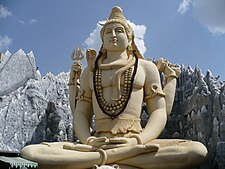
Maha Shivratri is a Hindu festival celebrated every year in reverence of Lord Shiva. Alternate common names/spellings include Maha Sivaratri, Shivaratri, Sivarathri, and Shivaratra. Shivaratri literally means the great night of Shiva or the night of Shiva. It is celebrated every year on the 13th night/14th day of the Maagha or Phalguna month of the Hindu calendar.
Lord Shiva was married to Devi Parvati on Shivratri. Remember Shiva minus Parvati is pure 'Nirgun Brahman'. With his illusive power, (Maya, Parvati) He becomes the "Sagun Brahman" for the purpose of the pious devotion of his devotees.It is also believed that on Shivratri, Lord Shiva became 'Neelkantham' or the blue-throated by swallowing the deadly poison that came up during the churning of "Kshir Sagar" or the milky ocean. The poison was so deadly that even a drop in His stomach, which represents the universe, would have annihilated the entire world. Hence, He held it in His neck, which turned blue due to the effect of poison. Shivratri is therefore also a day of thanksgiving to the Lord for protecting us from annihilation.
The festival is principally celebrated by offerings of Bael or Bilva/Vilvam leaves to Lord Shiva, all day fasting and an all night long vigil. From the very early morning, Shiva temples are flocked by devotees, mostly women, who come to perform the traditional Shivalinga worship and hence hope for favours from the god. Devotees bathe at sunrise, preferably in the Ganga, or any other holy water source (like the Shiva Sagartank at Khajurao). This is a purificatory rite, an important part of all Hindu festivals. Wearing a clean piece of clothing after the holy bath, worshippers carry pots of water to the temple to bathe the Shivalinga. They offer prayers to the sun, Vishnu and Shiva.Women pray for the well-being of their husbands and sons. An unmarried woman prays for a husband like Shiva, who is considered to be the ideal husband. The temple reverberates with the sound of bells and shouts of “Shankerji ki Jai” or 'Hail Shiva'. Devotees circumambulate the linga, three or seven times, and then pour water over it. Some also pour milk.